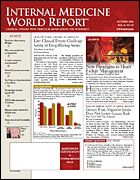Publication
Article
Internal Medicine World Report
Investigational Once-Yearly Bisphosphonate Shows Promise
Author(s):
From the American Society for Bone and Mineral Research
PHILADELPHIA—An investigational bisphosphonate, zoledronic acid, given as a once-yearly infusion, appears to be very effective in reducing the incidence of bone fracture in women with postmenopausal osteoporosis, according to data presented at the 28th Annual Meeting of the American Society for Bone and Mineral Research.
The Health Outcomes and Reduced Incidence with Zoledronic Acid Once Yearly (HORIZON) study, a multinational, multicenter, randomized, placebo-controlled trial, included a total of 7736 women. All participants received elemental calcium (1000-1500 mg/d) and vitamin D supplementation (400-1200 IU/d) in addition to the yearly infusion with zoledronic acid.
Primary end points were the number of new vertebral fractures and hip fractures at 3 years.
At 3 years’ follow-up, patients who were treated with zoledronic acid had a 70% lower risk for new spine fractures and a 40% lower risk for hip fracture compared with placebo. All secondary end points were also met, including risk reduction in spine and nonspine fractures.
The overall adverse events incidence was comparable in the 2 groups. The most common side effects were fever, muscle pain, flulike symptoms, headache, and bone pain, all of which resolved within 3 days after administration of the drug.
Another phase 3 study presented at the meeting showed sustained benefits in bone mineral density (BMD) and biomarkers after 12 months with zoledronic acid in 225 postmenopausal women with low BMD who had been treated with alendronate (Fosamax) for at least 1 year.
This randomized, double-blind, multicenter trial compared a single infusion of zoledronic acid, 5 mg, with continued weekly oral alendronate therapy, 70 mg, for a period of 52 weeks. The primary end point was the change in lumbar spine BMD from baseline.
The benefits of alendronate on BMD levels were maintained for the 12 months after a single infusion of zoledronic acid; BMD values for patients randomized to zoledronic acid were similar to those in the continued alendronate therapy group.
“Essentially, we found no differences between the 2 groups of patients,” said lead investigator Michael McClung, MD, FACP, director, Oregon Osteoporosis Center, Portland. “Many people have the perception that they have upper gastrointestinal symptoms with alendronate, and taking this drug intravenously avoids that entirely, and many people find taking the tablets inconvenient because they have to follow certain dosing rules.”
Dr McClung speculates this new agent could improve compliance. Analysis of key safety parameters, including effects on the kidney and jaw, suggested that zoledronic acid was as safe as placebo.
“Primary care physicians should know that once zoledronic acid becomes available, if there are patients who have been taking alendronate and are deemed candidates for treatment, that the switch can be made safely, and the effect of controlling the osteoporosis persists with the switch,” Dr McClung told IMWR.
Zoledronic acid is approved in about 50 countries for Paget’s disease, sold under the name Aclasta. In this country the drug will be called Reclast.





